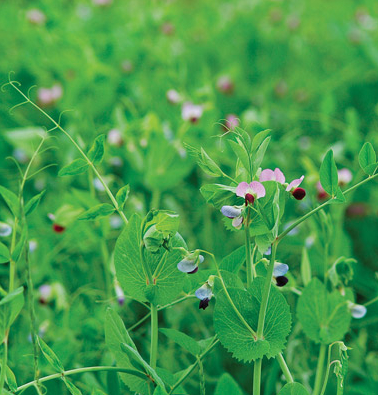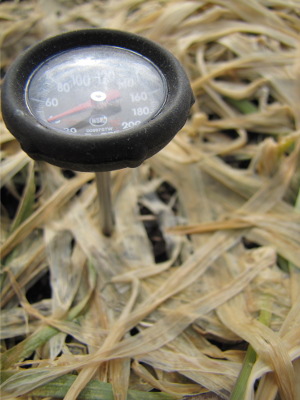
Spring cover crops
 Last year, I remember
thinking that it was wasteful to have half of the garden fallow until
May, with some beds being held open all the way until June.
Sounds like a spot for spring cover crops!
Last year, I remember
thinking that it was wasteful to have half of the garden fallow until
May, with some beds being held open all the way until June.
Sounds like a spot for spring cover crops!
The goal for fall
cover crops is usually weed suppression and soil building, but
spring cover crops are often used to boost soil nitrogen so you don't
need to add so much compost to the soil. I've narrowed down our
spring cover crop choices to one familiar candidate and one newbie:
- Oats don't add nitrogen to the soil, but they can be planted much earlier than other spring cover crops. Although soil temperature is variable from year to year, I suspect we'll achieve their recommended planting temperature of 38 degrees Fahrenheit in February or early March. That will give the oats their full six to ten week growing season before I mow them down in mid to late April, and the leaves can decompose a bit and then provide mulch through the summer.
- Field peas are a good source of nitrogen and their flowers are an early source of nectar for honeybees too. Field pea residue breaks down quickly in the soil, so it's best to plant the legumes where I'm going to be direct-seeding summer crops and need bare soil. I suspect we can plant field peas in early March (minimum soil temperature 41 degrees Fahrenheit) and give them a couple of months to grow before mowing them down in time to plant our summer crops.
 Since I have about 35 pounds
of oat seed leftover from the fall and only an expensive 1 pound of
field pea seeds on their way from Johnny's Select Seeds, I suspect I'll
plant mostly oats for my spring cover crop. I do want to try at
least one bed of oats and field peas together, though, since the two
make a good duo --- the oats give the peas something to grow up, and
when the cover crops are mowed down the high nitrogen peas give the
mixture a C:N ratio that promotes more rapid decomposition.
Since I have about 35 pounds
of oat seed leftover from the fall and only an expensive 1 pound of
field pea seeds on their way from Johnny's Select Seeds, I suspect I'll
plant mostly oats for my spring cover crop. I do want to try at
least one bed of oats and field peas together, though, since the two
make a good duo --- the oats give the peas something to grow up, and
when the cover crops are mowed down the high nitrogen peas give the
mixture a C:N ratio that promotes more rapid decomposition.
At the moment, though,
our soil temperature is hovering right around freezing (a little warmer
in the sunny mule garden and a little colder in the shadiest end of the
front garden), so I've got to wait a while before planting.
Want more in-depth information? Browse through our books.
Or explore more posts by date or by subject.
About us: Anna Hess and Mark Hamilton spent over a decade living self-sufficiently in the mountains of Virginia before moving north to start over from scratch in the foothills of Ohio. They've experimented with permaculture, no-till gardening, trailersteading, home-based microbusinesses and much more, writing about their adventures in both blogs and books.
Want to be notified when new comments are posted on this page? Click on the RSS button after you add a comment to subscribe to the comment feed, or simply check the box beside "email replies to me" while writing your comment.

http://rivermud.blogspot.com/2011/04/garden-cover-crop-field-trial-results.html
Plant the peas in the late fall and get pretty impressive coverage - I'm about to mow them for our last frost date and they are 2' tall. Haven't bloomed yet.
I also have a garden with early spring planted peas and it's not even in the same ballpark. Plants are maybe 5" tall. At most.
Yes, I've tried Austrian Field peas (most successful), cow peas (OK), NZ clover (bad), mammoth red clover (OK), crimson clover (bad), and berseem white clover (bad).
Mixing in oats with the field peas this fall....mice instantly got into the rows and tried to eat all the oats. Oh well.